Mechanisms of embryonal tumor initiation: distinct roles for MycN expression and MYCN amplification
- PMID: 15314226
- PMCID: PMC515113
- DOI: 10.1073/pnas.0401083101
Mechanisms of embryonal tumor initiation: distinct roles for MycN expression and MYCN amplification
Abstract
The mechanisms causing persistence of embryonal cells that later give rise to tumors is unknown. One tumorigenic factor in the embryonal childhood tumor neuroblastoma is the MYCN protooncogene. Here we show that normal mice developed neuroblast hyperplasia in paravertebral ganglia at birth that completely regressed by 2 weeks of age. In contrast, ganglia from MYCN transgenic (TH-MYCN) mice demonstrated a marked increase in neuroblast hyperplasia and MycN expression during week 1. Regression of neuroblast hyperplasia was then delayed and incomplete before neuroblastoma tumor formation at 6 and 13 weeks in homo- and hemizygote mice, respectively. Paravertebral neuronal cells cultured from perinatal TH-MYCN mice exhibited 3- to 10-fold resistance to nerve growth factor (NGF) withdrawal, compared with normal mice. Both low- and high-affinity NGF receptors were expressed in perinatal neuroblast hyperplasia but not in neuroblastoma tumor tissue. MYCN transgene amplification was present at low levels in perinatal neuroblast hyperplasia from both homo- and hemizygote TH-MYCN mice. However, only in hemizygous mice did tumor formation correlate with a stepwise increase in the frequency of MYCN amplification. These data suggest that inappropriate perinatal MycN expression in paravertebral ganglia cells from TH-MYCN mice initiated tumorigenesis by altering the physiologic process of neural crest cell deletion. Persisting embryonal neural crest cells underwent further changes, such as MYCN amplification and repression of NGF receptor expression, during tumor progression. Our studies provide a model for studying perinatal factors influencing embryonal tumor initiation.
Figures
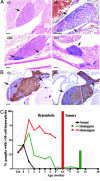
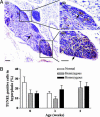

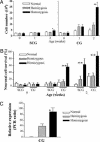
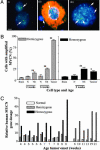
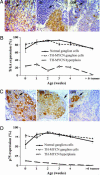
Similar articles
-
Tumor development, growth characteristics and spectrum of genetic aberrations in the TH-MYCN mouse model of neuroblastoma.PLoS One. 2012;7(12):e51297. doi: 10.1371/journal.pone.0051297. Epub 2012 Dec 17. PLoS One. 2012. PMID: 23284678 Free PMC article.
-
ODC1 is a critical determinant of MYCN oncogenesis and a therapeutic target in neuroblastoma.Cancer Res. 2008 Dec 1;68(23):9735-45. doi: 10.1158/0008-5472.CAN-07-6866. Cancer Res. 2008. PMID: 19047152 Free PMC article.
-
MYCN and ALKF1174L are sufficient to drive neuroblastoma development from neural crest progenitor cells.Oncogene. 2013 Feb 21;32(8):1059-65. doi: 10.1038/onc.2012.106. Epub 2012 Apr 9. Oncogene. 2013. PMID: 22484425
-
Neuroblastoma and MYCN.Cold Spring Harb Perspect Med. 2013 Oct 1;3(10):a014415. doi: 10.1101/cshperspect.a014415. Cold Spring Harb Perspect Med. 2013. PMID: 24086065 Free PMC article. Review.
-
MDM2 as MYCN transcriptional target: implications for neuroblastoma pathogenesis.Cancer Lett. 2005 Oct 18;228(1-2):21-7. doi: 10.1016/j.canlet.2005.01.050. Cancer Lett. 2005. PMID: 15927364 Review.
Cited by
-
Molecular imaging of neuroblastoma progression in TH-MYCN transgenic mice.Mol Imaging Biol. 2013 Apr;15(2):194-202. doi: 10.1007/s11307-012-0576-9. Mol Imaging Biol. 2013. PMID: 22777578 Free PMC article.
-
Murine neuroblastoma cell lines developed by conditional reprogramming preserve heterogeneous phenotypes observed in vivo.Lab Invest. 2020 Jan;100(1):38-51. doi: 10.1038/s41374-019-0297-7. Epub 2019 Aug 13. Lab Invest. 2020. PMID: 31409888 Free PMC article.
-
Histone demethylase KDM6B has an anti-tumorigenic function in neuroblastoma by promoting differentiation.Oncogenesis. 2019 Jan 4;8(1):3. doi: 10.1038/s41389-018-0112-0. Oncogenesis. 2019. PMID: 30631055 Free PMC article.
-
Caffeine Supplementation and FOXM1 Inhibition Enhance the Antitumor Effect of Statins in Neuroblastoma.Cancer Res. 2023 Jul 5;83(13):2248-2261. doi: 10.1158/0008-5472.CAN-22-3450. Cancer Res. 2023. PMID: 37057874 Free PMC article.
-
Cellular senescence in neuroblastoma.Br J Cancer. 2022 Jun;126(11):1529-1538. doi: 10.1038/s41416-022-01755-0. Epub 2022 Feb 23. Br J Cancer. 2022. PMID: 35197583 Free PMC article. Review.
References
-
- Freeman, R. S., Estus, S. & Johnson, E. M., Jr. (1994) Neuron 12, 343-355. - PubMed
-
- Woods, W. G., Gao, R. N., Shuster, J. J., Robison, L. L., Bernstein, M., Weitzman, S., Bunin, G., Levy, I., Brossard, J., Dougherty, G., et al. (2002) N. Engl. J. Med. 346, 1041-1046. - PubMed
-
- Brodeur, G. M. (2003) Nat. Rev. Cancer 3, 203-216. - PubMed
Publication types
MeSH terms
Substances
LinkOut - more resources
Full Text Sources
Other Literature Sources
Medical
Molecular Biology Databases

